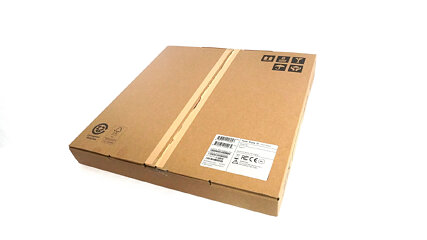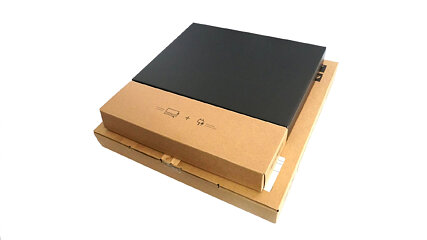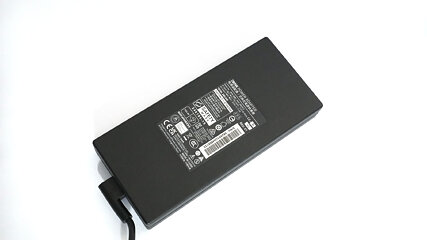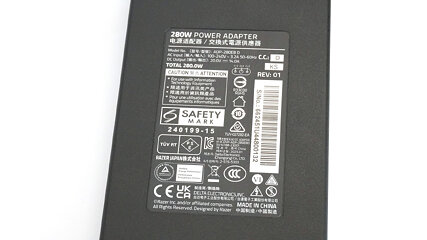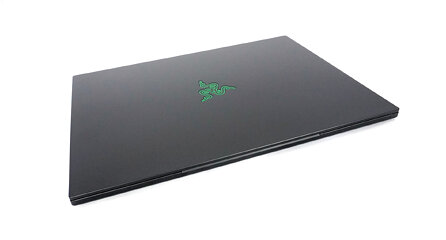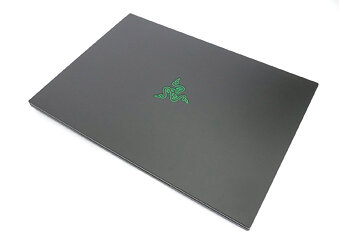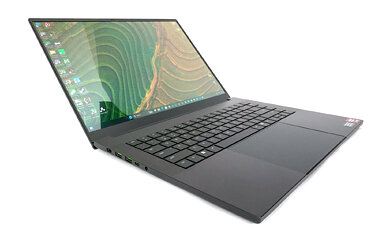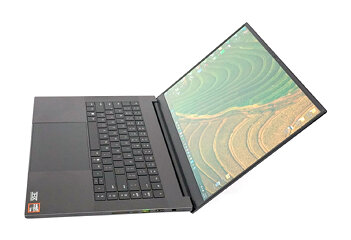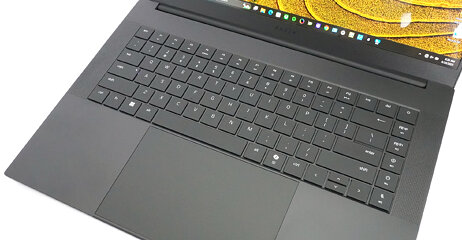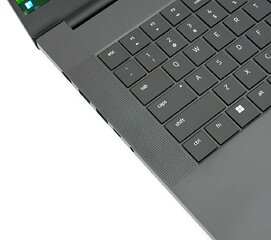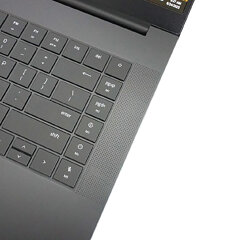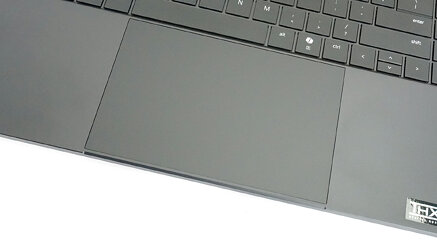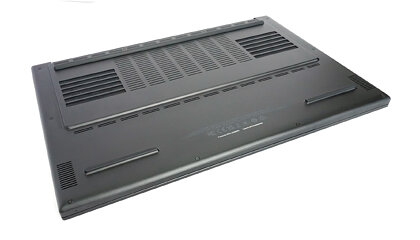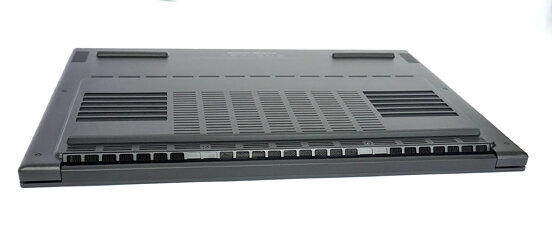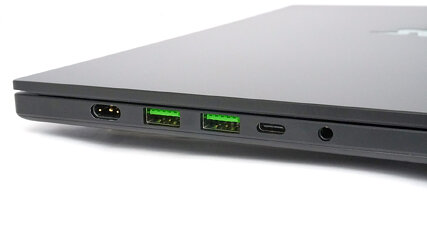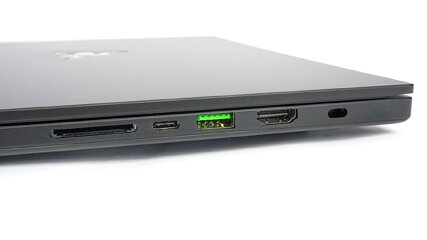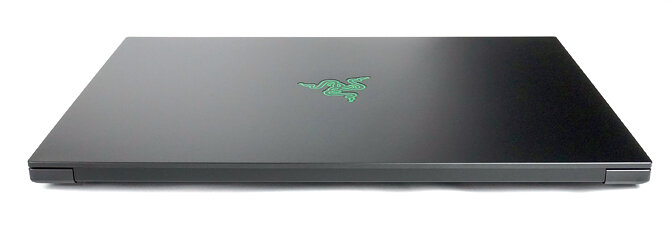 19
19
Razer Blade 16 (2025) Review - Thin, Light, Punchy, and Efficient
(19 Comments) »Introduction

While gaming laptops have always tended towards chunkiness, in recent years they've been getting larger as well, 16 and 18 inch devices are quite popular, associated with halo tier rigs for the discerning gamer and creator. While these machines certainly became more powerful and refined over the years, we're now seeing 4-kilo devices become surprisingly common, even sporting external liquid cooling apparatus in the most extreme cases. The average laptop is meant for portability and ease of use, trying to haul a four-kilo 18-inch monster with massive—and sometimes multiple—heavy power adapters somewhat defeats that purpose. But even these desktop replacement monsters still take less space than most conventional desktop PCs.

Razer laptops have a pedigree of introducing cutting edge form factors, with a tradition of wrapping serious hardware in a svelte chassis, utilizing top tier displays, and being one of the first laptop manufacturers to use large vapor chambers. Unlike many Apple devices, which have similar aesthetics, Razer incorporates a wide selection of fast ports and connectivity with their machines, emphasizing practicality alongside style. With the 2025 version of the Blade 16, Razer aims to further prove that a notebook meant for hardcore gaming and content creation can be very portable, even when it's rocking a GB203 based RTX 5090 under the hood. This device looks great on paper, and it's even more impressive when you see it in action. Sporting a sleek CNC machined anodized aluminium, sub-18 mm profile and weighing just over 2 kg, it's genuinely portable, without compromising on durability or feelings of solidness. Despite these ambitious design goals, the cooling has been incorporated well enough that the RTX 5090 sustains around 150 W during gaming. I don't know about you guys, but this sounds tempting to me!
Razer paired the NVIDIA Blackwell GPUs with AMD Zen 5 Strix Point HX-series processors. You can choose between the Ryzen AI 9 365 or its more powerful sibling, the Ryzen AI 9 HX 370—both have 4 Zen 5 and some Zen 5c cores, but the HX 370 has two additional Zen 5c cores and slightly higher frequencies—for a 4+6 or 4+8 setup. Thankfully, since the Zen 5c cores, while capable, are generally better suited for background tasks, six versus eight isn't a big deal, actual gaming performance will be very similar for the two chips on offer, which both use their full fat Zen 5 cores for gaming and foreground tasks, with the area efficient Zen 5c cores picking up the slack if needed. Unfortunately, and with that said, the HX 370 option is only available when paired with the RTX 5090, a combo that adds a jaw-dropping $2100 to the base price. That's not exactly the best marketing strategy that I have ever seen, it seems these locked combos are for the convenience of Razer, offering fewer SKUs to support, rather than to provide customers with the best selection of choices.
Speaking of which, most of the upgrades are costly and tied to other options, Razer seems to be taking a page out of the Apple playbook, despite this platform not sharing the technical limitations that cause various versions of the M-series SoCs, for instance, to physically max out at various levels of unified memory. There is no such limitation with the x86 CPUs and LPDDR5X memory here. For instance, the base model comes with just 16 GB of soldered LPDDR5X RAM, meaning you can't even get an RTX 5060-based Blade 16 with 32 GB of memory, arguably the entry level for DDR5 gaming machines in 2025. If you need a machine with that amount of memory, you'll have to pay an additional $400 for an RTX 5070 + 32 GB combo. Furthermore, if you're looking for 64 GB, those configurations are only available with the RTX 5080 and 5090. Considering these soldered memory options cannot be upgraded at a later date, locking prospective buyers to 16 GB configurations reminiscent of the DDR4 era is pretty shameful.
With a ClearMR 11000 and DisplayHDR True Black 500 rating, both certified by VESA, the Calman Verified display is beautiful! It's a 16-inch 16:10 OLED with a 2560x1600 resolution, giving more vertical resolution real estate than standard 16:9 panels. Gaming on this 240 Hz panel is a joy since the color reproduction is excellent, HDR scenes are rendered in a stunning fashion, and it has a 0.2 ms response time, giving a feeling of instantaneous clarity in fast-paced scenes—more so than IPS or mini-LED panels of the same refresh rate could offer.
The port selection is more than generous, featuring three 10 Gbps Type-A and two USB4 Type-C ports which support 100 W PD and DP 1.4, plus a fast UHS-II microSD card reader. NVIDIA G-Sync is also available on either the internal display or outputted through the HDMI 2.1 port. It's manually toggleable with a MUX switch in the BIOS, or you can enable Optimus/Advanced Optimus switching between integrated and discrete graphics. It's a bit of a mystery for me why this option stays hidden in the BIOS, and you don't have direct access to it. Thankfully, Razer also offers a guide on how to enable NVIDIA Advanced Optimus in the NVIDIA Control panel, which has improved logic for when to use the integrated or the discrete GPU, automatically, so users don't have to restart and manually switch every time.
Besides a sleek profile, low weight and good battery life, this Razer Blade 16 delivers all the premium features you'd expect from a top-tier gaming machine, such as a robust metal build, efficient vapor chamber cooling combined with phase change TIM, high-end hardware, and a stunning display. Let's see how the Blade does in our suite of testing!
Specifications
| Specifications | |
|---|---|
| Manufacturer: | Razer |
| Model: | Razer Blade 16 (2025) |
| Weight: | 2.14 kg |
| Processor: | AMD Ryzen AI 9 HX 365 / Zen 5 Strix Point-HX 4 Zen 5 P-Cores + 6 Zen 5c E-cores / 20 threads up to 5.0 GHz, 24 MB L3 cache 28+ W Base Power AMD Ryzen AI 9 HX 370 / Zen 5 Strix Point-HX 4 Zen 5 P-Cores + 8 Zen 5c E-cores / 24 threads up to 5.1 GHz, 24 MB L3 cache 28+ W Base Power |
| Chipset: | AMD Promontory/Bixby FCH |
| Default Display: | 16.0" / 2560×1600 (16:10) / OLED / 240 Hz ~400 nits / 100% sRGB / glossy |
| Operating System: | Windows 11 Home |
| Integrated Graphics: | AMD Radeon 890M |
| Dedicated Graphics: | NVIDIA GeForce RTX 5060 (mobile): 8 GB GDDR7, 128 Bit, 1500 MHz effective clock 3328 CUDA Cores 104 TMUs 48 ROPs 26 RT Cores 104 Tensor Cores L1: 3.3 MB, L2: 32 MB NVIDIA GeForce RTX 5070 (mobile): 8 GB GDDR7, 128 Bit, 1500 MHz effective clock 4608 CUDA Cores 144 TMUs 38 ROPs 36 RT Cores 144 Tensor Cores L1: 4.6 MB, L2: 32 MB NVIDIA GeForce RTX 5070 Ti (mobile): 12 GB GDDR7, 192 Bit, 2000 MHz effective clock 5888 CUDA Cores 184 TMUs 64 ROPs 46 RT Cores 184 Tensor Cores L1: 5.8 MB, L2: 48 MB NVIDIA GeForce RTX 5080 (mobile): 16 GB GDDR7, 256 Bit, 1750 MHz effective clock 8192 CUDA Cores 256 TMUs 96 ROPs 64 RT Cores 256 Tensor Cores L1: 8 MB, L2: 64 MB NVIDIA GeForce RTX 5090 (mobile): 24 GB GDDR7, 256 Bit, 1750 MHz effective clock 10496 CUDA Cores 328 TMUs 112 ROPs 82 RT Cores 328 Tensor Cores L1: 10.3 MB, L2: 64 MB Up to 175 W TGP |
| Memory: | Soldered RAM Up to 64 GB of LPDDR5X at 8000 MT |
| Storage: | 2x M.2 2280 PCI Express 4.0 x4 |
| Optical Drive: | None |
| Connectivity: | 3x USB Type-A / 3.2 Gen. 2 / 10 Gbps 2x 40 Gbps USB4 with DisplayPort 1.4 and up to 100 W PD 3.0 1x HDMI 2.1 /G-SYNC compatible Audio combo jack DC-in microSD card reader (UHS-II) |
| Communications: | Wi-Fi 7 + Bluetooth 5.4 1080p webcam, Windows Hello compatible |
| Audio: | 6x stereo speakers with Smart Amp |
| Input device: | Multi-gesture Microsoft Precision glass touchpad (automatic palm rejection) Per-Key RGB-backlit keyboard with N-key rollover, 1.5 mm travel, 5x dedicated macro keys |
| Power: | 1x 280 W (or 200 W) AC adapter 90 Wh battery |
| Warranty: | 2 year |
| MSRP: | Starting at €2399 / $2399 / £2099 |
Packaging
The main box is a quite flat one. It contains two smaller packages—one for the laptop and its 280 W charger. The less powerful configurations come with 200 W chargers. It's unclear whether these are GaN models, which offer higher efficiency and are thus smaller and lighter. Razer does offer these GaN units on it's store, so it's certainly a possibility.
By the way, the charger may look big (18 x 8.2 x 2.4 cm), but it's not exactly huge. Still, it weighs 696 grams which isn't light at all, but I've seen heftier chargers too.
A Closer Look - Outside
What a looker! The black chassis of the Razer Blade 16 is made of CNC-milled aluminium with a dark anodized anti-fingerprint finish. Well, the coating doesn't fully live up to its name since some smudges are still noticeable. Still, the thin metal body feels well crafted and not too gamer-centric. The illuminated Razer logo at the center of the lid reminds you that this isn't an ordinary machine.
You can open the Blade 16 with just one finger. A generous cutout in front of the touchpad lets you slip your finger under the lid and lift it. The lid is super thin for such a device, it feels a bit more flexible than usual in the center. While you can twist it slightly, that's pretty standard for such a slim laptop. However, the base is solid, and while the laptop is closed in it's traveling posture, any potential lid flexing should be a non-issue.
Razer states a 1.5 mm travel for the per-key RGB Razer Chroma compatible keyboard. This means each key can have its function and lighting customized, and it doesn't feel bad at all. Sure, I've felt better—especially from desktop mechanical keyboards or desktop replacement laptops with twice the weight and thickness—but the slim chassis Razer crafted is the limiting factor here, and the results are still good enough for accurate typing and gaming. The keycaps are big, and they are accompanied by an AI shortcut and not-so-large arrow keys (the "Up" and "Down" ones are on the smaller side). The keyboard with eleven preprogrammed lighting effects—custom lighting configurations can be created by the user or downloaded through the Synapse software—is described as a Dual LED unit. If you are hesitating about what the meaning behind this branding is, well, you press and hold the Shift or Function key, and those secondary LEDs will light up the keys that have layered second functions. The five macro keys on the far right side of the board are a bit awkwardly placed; I found myself too often hitting "M3" or "M2" instead of "Enter."
Tall speaker grilles are on each side of the keyboard. That's why you don't get a dedicated numpad, though of course Synapse allows programming of layers to achieve a virtual one on existing keys. The laptop is of course compatible with external keyboards—whether wireless or wired—and fits neatly into the Razer ecosystem of peripherals, all controlled by Synapse.
The Microsoft Precision glass touchpad is huge, and it's placed in the center of the front side of the upper body. It works well, the surface is pleasantly smooth, clicking produces a minimal amount of noise, and palm rejection seems to function as intended.
The 1080p IR webcam on top of the screen is compatible with Windows Hello. However, it lacks a privacy shutter, something more and more common even on even low-end machines these days as privacy concerns become more mainstream. At least the resolution is decent, and those concerned about privacy can always apply some tape. The thin aesthetically optimized edge-to-edge display is likely to blame for this deficiency, though a solution could probably have been found with more engineering effort.
The bottom plate houses three feet, a generous amount of ventilation grilles, and two cutouts for the speakers. The fans are visible through the mesh that covers them.
The hot air is pushed outside through rear-positioned vents only. It's not something unusual for a thin laptop, but a fair amount of hot air warms up the display while you're playing games, something that could be concerning for those aware of the relationship between heat and longevity for OLED panels.
Ports and Connectivity
An audio combo jack and 40 Gbps USB4 port, followed by two 10 Gbps USB Type-A 3.2 Gen. 2 ports and a power port are on the left.
The right side is populated by a microSD card reader (UHS-II), another 40 Gbps USB4 port, one more 10 Gbps Type-A, an HDMI 2.1, and a Lock slot.
The two Type-C ports are quite versatile, offering 100 W Power Delivery (when a 20 V charger is connected) and DisplayPort 1.4 capabilities.
If you don't need the full performance of the system and can live with a 100 W power budget when going out and about, topping up with one of the modern GaN phone charger sized units or even battery banks with sufficient output is viable. Razer even offers a 140 W GaN unit of their own that is sufficient to charge the laptop and a smartphone at the same time.
No ports on the back!
Our Patreon Silver Supporters can read articles in single-page format.
Jul 24th, 2025 16:13 CDT
change timezone
Latest GPU Drivers
New Forum Posts
- Corsair RM850x (2021) 12V Rail Dropping — Causing Crashes While Gaming (3)
- [USA] [Newegg] PCCOOLER CPS RZ620 Dual Tower CPU Air Cooler $23 (regular $70) same cooler I own currently (it even beats 360 AIO water coolers) (8)
- Lexar NM790 (4TB) made my PC go back to Windows XP days, since it caused my PC to be SO slow and laggy! (21)
- Which Linux flavor? (54)
- AI Job Losses: let's count the losses up, total losses to AI so far 94,000 and counting (60)
- RX 9000 series GPU Owners Club (1193)
- Share your CPUZ Benchmarks! (2533)
- What are these keycaps? (1)
- Need some help finding correct VBIOS for my RX580 (8)
- What's your latest tech purchase? (24356)
Popular Reviews
- Noctua NF-A12x25 G2 PWM Fan Review
- MSI MPG B850I Edge Ti Wi-Fi Review
- Cougar OmnyX Review
- Thermal Grizzly WireView Pro Review
- UPERFECT UMax 24 Review
- TerraMaster F4-424 Max Review - The fastest NAS we've tested so far
- Sharkoon OfficePal C10 Review - Affordable and Decent
- Razer Blade 16 (2025) Review - Thin, Light, Punchy, and Efficient
- Upcoming Hardware Launches 2025 (Updated May 2025)
- VAXEE XE V2 Wireless Review
TPU on YouTube
Controversial News Posts
- Some Intel Nova Lake CPUs Rumored to Challenge AMD's 3D V-Cache in Desktop Gaming (140)
- AMD Radeon RX 9070 XT Gains 9% Performance at 1440p with Latest Driver, Beats RTX 5070 Ti (131)
- AMD's Upcoming UDNA / RDNA 5 GPU Could Feature 96 CUs and 384-bit Memory Bus (116)
- NVIDIA GeForce RTX 5080 SUPER Could Feature 24 GB Memory, Increased Power Limits (115)
- NVIDIA DLSS Transformer Cuts VRAM Usage by 20% (99)
- AMD Sampling Next-Gen Ryzen Desktop "Medusa Ridge," Sees Incremental IPC Upgrade, New cIOD (97)
- NVIDIA Becomes First Company Ever to Hit $4 Trillion Market-Cap (94)
- Windows 12 Delayed as Microsoft Prepares Windows 11 25H2 Update (92)
